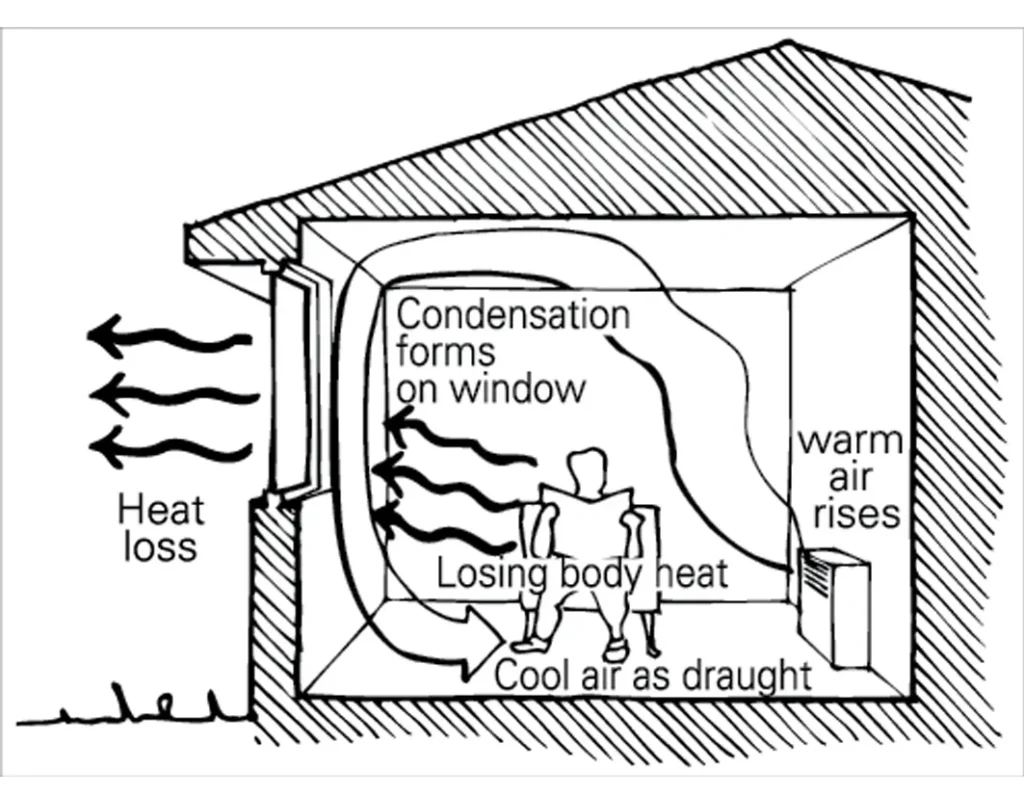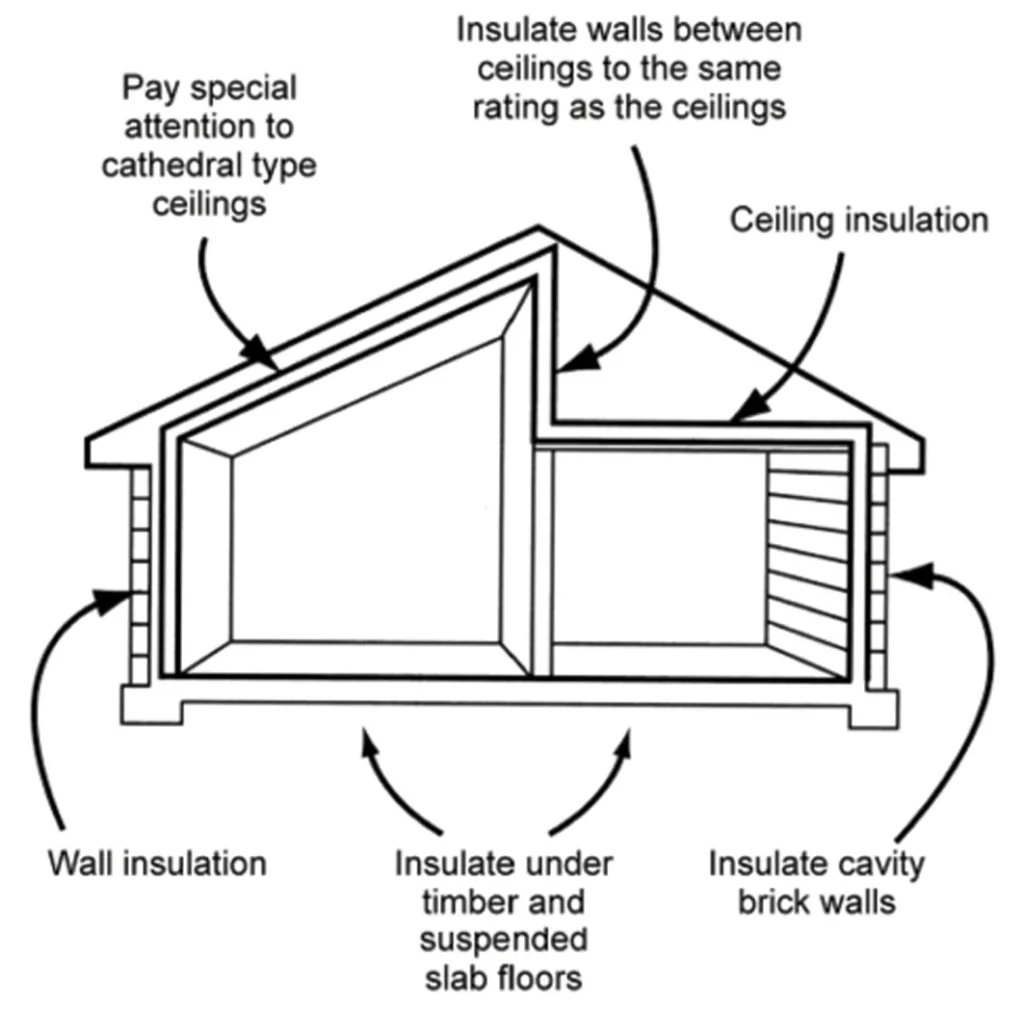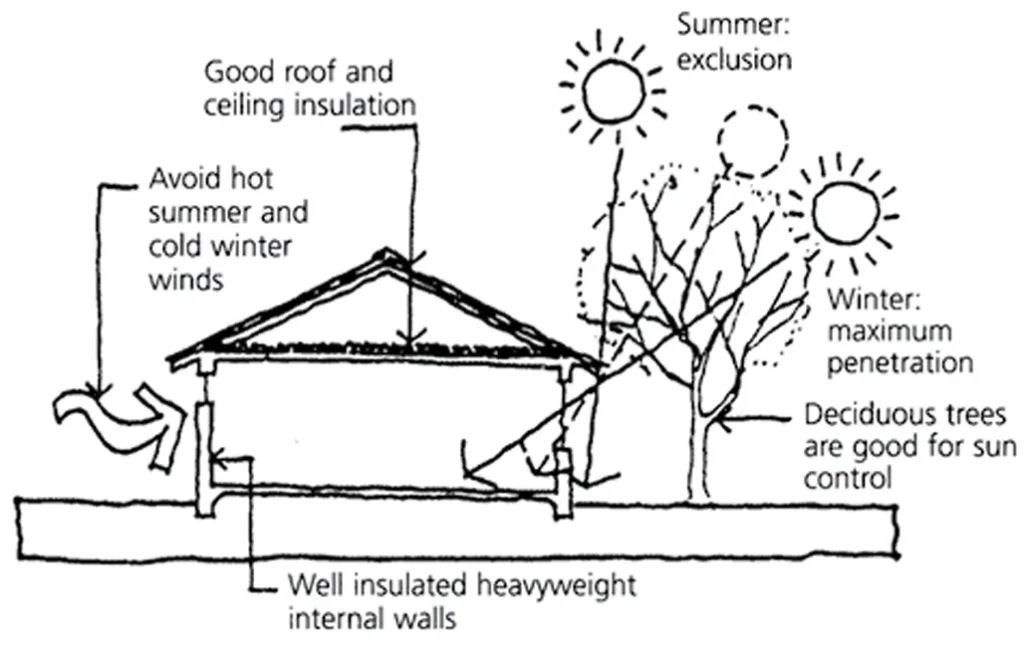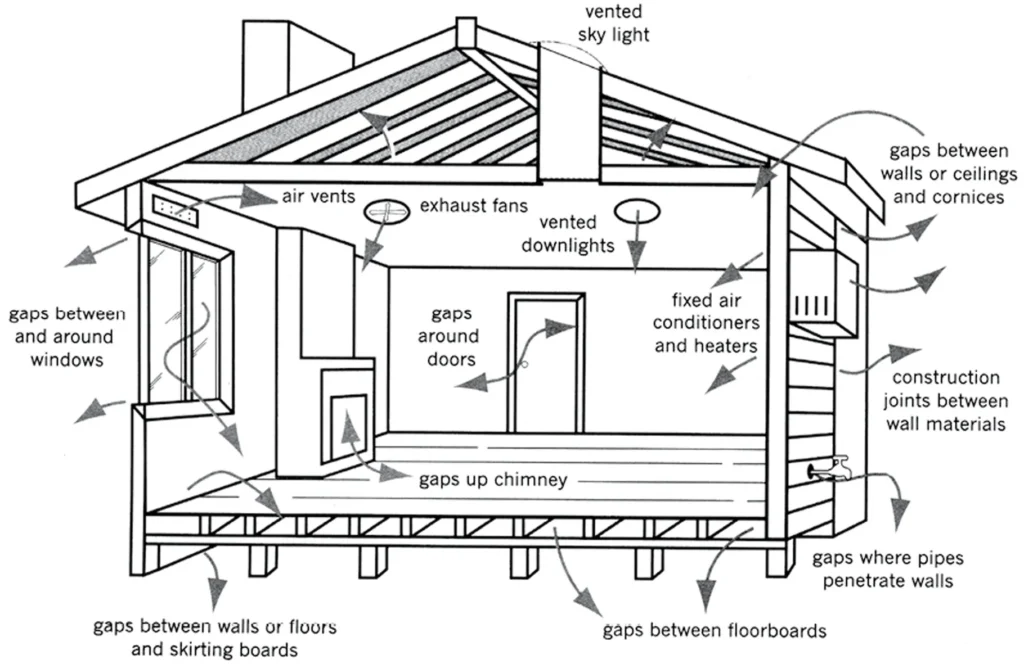If you want to know about the sustainable building design or site analysis or introduction of passive design, please click the link.
Passive solar heating is a technique used to collect, store, and distribute solar energy within a building without the use of mechanical or electrical systems. When planning a building to incorporate passive solar heating, the following factors should be taken into consideration.
Planning and design
Plan carefully to ensure passive solar gain to the rooms that most need it.
1) Floor planning

This plan places living areas to the north and bedrooms to the south.
- In general, group living areas along the north façade and bedrooms along the south or east façade.
- Living areas and the kitchen are usually the most important locations for passive heating as they are used day and evening.
- Bedrooms generally require less heating.
- It is easy to get warm and stay warm in bed. Children’s bedrooms can be classified as living areas if considerable hours are spent there.
- Utility and service areas such as bathrooms, laundries and garages are used for shorter periods, require smaller windows and generally require less heating.
- These areas are best located:

to the west or south-west, to act as a buffer to hot afternoon sun and the cold westerly winds common to many regions
to the east and south-east, except where this is the direction of cooling breezes.
- Detached garages to the east and west can create protected north-facing courtyards, provide shade from low angle summer sun and direct cooling breezes into living spaces.
- Compact floor plans minimise external wall and roof area, thereby reducing heat loss and construction cost.
- Determine a balance between minimising heat loss and achieving adequate daylighting and ventilation.
- Consider specific regional heating and cooling needs and the site characteristics to determine an ideal building shape.
2) Locating thermal mass
- As a first priority, locate thermal mass where it is exposed to direct solar radiation or radiant heat sources.
- Insulated or internal suspended slabs that are not earth-coupled make ideal thermal mass storage for solar heat gains, as do masonry walls, water filled containers and phase change materials.
- They should receive direct solar radiation.
- Thermal mass also absorbs reflected radiant heat.
- Thermal mass walls between northern living areas and southern sleeping areas are ideally located as thermal lag radiates daytime solar gains into sleeping areas at night and provides acoustic separation.
- Locate additional thermal mass predominantly in the northern half of the house where it absorbs most passive solar heat.
- Earth-coupled concrete slabs-on-ground are not an ideal storage medium for solar gains.
- They have an almost endless capacity to absorb heat with very little temperature rise due to their capacity to ‘wick’ heat away through earth-coupling. Their main role in passive design is to maintain overnight temperatures at deep earth temperature levels (16–19°C at 3m depth) that can easily be topped up by solar gains or auxiliary heating next day.
- In cold climates, insulate under areas of slab-on-ground that are exposed to direct solar radiation and insulate all edges.
- Consider use of low thermal mass materials and high levels of insulation in south-facing rooms.
- Air movement within the house heats or cools thermal mass. Locate mass away from cold draught sources (e.g. entries) and expose it to convective warm air movement in the house (e.g. hallways to bedrooms). Consider the balance between heating and cooling requirements.

Locate thermal mass where it is exposed to direct solar radiation.
- Edge insulation is desirable for earth-coupled slabs, especially in colder areas.
- Earth-coupling should be avoided where groundwater action or temperatures can draw heat from slabs.
3) Air movement and comfort
- Air movement creates a cooling effect on our bodies by increasing the evaporation of perspiration.
- Draughts increase the perception of feeling cold. Air movement of 0.5m/s (barely enough to move a sheet of paper) creates a cooling effect equivalent to a 3°C drop in temperature.
- Avoid convection draughts by designing floor plans and furnishing layouts so that cool air flowing from windows and external walls towards heaters or thermal mass sources is directed through traffic areas such as hallways and stairs.
- Create draught free nooks for sitting, dining and sleeping.
- Use ceiling fans to circulate warm air evenly in rooms and push it down from the ceiling to living areas. For low ceilings, use fans with reversible blade direction to minimise draughts.

Adverse effects of draughts.
4) Locating heaters
- Internal thermal mass walls provide an ideal location for heaters, especially radiant units such as wood heaters or hydronic heating panels.
- Thermal lag will transfer heat to adjoining spaces over extended periods (see Heating and cooling).
- Locating heaters next to an outside wall can result in additional heat loss (unless they are well insulated), as increasing the temperature differential between inside and out increases the rate of heat flow through the wall.
- Do not locate heaters under windows.
- As heaters create draughts when operating, try to locate them where they can draw cooled air back through passageways rather than sitting areas.
5) Design for heat distribution
- Convection currents are created when warmer air rises to the ceiling and air cooled by windows and external walls is drawn back along the floor to the heat source.
- With careful design, convective air movement can be used to great benefit but with poor design can be a major source of thermal discomfort.
- Analyse warm air flows by visualising a helium filled balloon riding the thermal currents. Where would it go? Where would it be trapped? Cool air flows are drawn by gravity and fall towards the lower levels of your rooms — use incense sticks to track air flows in your existing home.
6) Single storey homes
- Minimise convective air movement in winter with wall and ceiling insulation and glazing.
- The convection that still occurs is a major means of passive heat distribution in any home.
- Controlled convection can be used to warm rooms not directly exposed to heat sources; it can also reduce unwanted heat loss from rooms that do not require heating.
- Opening or closing doors controls the return air flow but impacts on privacy.
- Use vents that can be opened or sealed.
- Openable panels (louvres or transom windows) over doors promote and control movement of the warmest air at ceiling level while retaining privacy.
- Floor to ceiling doors are effective in facilitating air movement but are often closed for privacy.
7) Multi-storey homes
- Place most thermal mass and the main heating sources at lower levels.
- Use high insulation levels and lower (or no) thermal mass at upper levels.
- Ensure upper levels can be closed off to stop heat rising in winter and overheating in summer.
- Use stairs to direct cool air draughts back to heat sources, located away from sitting areas.
- Avoid open rails on stairwells, balconies and voids. They allow cool air to fall like a waterfall into spaces below.
- Use ceiling fans or heat shifters (see Heating and cooling) to push warm air back to lower levels.
- Minimise window areas at upper levels and double glaze. Use close fitting drapes with snug pelmet boxes.
- Maximise the openable area of upper level windows for summer ventilation. Avoid fixed glazing.
- Locate bedrooms upstairs in cold climates so they are warmed by rising air.
8) Preventing heat loss
- Preventing heat loss is an essential component of efficient home design in any climate.
- It is even more critical in passive solar design as the primary heat source is only available during the day.
- The building fabric must retain energy collected during the day for up to 16 hours and considerably longer in cloudy weather.
- To achieve this, pay careful attention to each of the following factors:
- windows and glazing
- insulation
- draught sealing
- air locks.
9) Windows and glazing
- In terms of energy efficiency, glazing is a critical element of the building envelope, transferring both radiant and conducted heat.
- In insulated buildings it is where most heat is lost and gained.
Avoid over-glazing — excessive areas of glass can be an enormous energy liability.
- Daytime heat gain must be balanced against night-time heat loss when selecting glazing and sizing windows.
- In winter, there are five hours or less of solar heat gain but 19 or more hours of night-time heat loss.
- Low conductivity or U-value (e.g. double glazing) and high solar heat gain coefficients are required in cool and cold climates but should be adjusted as cooling needs increase.
- Window frames also conduct heat. Use timber, PVC or thermally separated metal window frames in cooler climates (and hotter climates where air conditioning is used).
- Views are an important consideration and are often the cause of over-glazing or inappropriate orientation and shading. Plan carefully, especially for shading and advanced glazing options, to capitalise on views without decreasing energy efficiency.
- There are many ways to reduce heat loss through glazing.
10) Insulation
- High insulation levels are essential in passive solar houses.
- Ceilings and roof spaces account for 25–35% of winter heat loss and must be well insulated.
- To prevent heat loss, place most of the insulation next to the ceiling as this is where the greatest temperature control is required.

Principles of good insulation.
Floors account for 10–20% of winter heat loss.
In cool climates insulate the underside of suspended timber floors and suspended concrete slabs.
- Insulate the edges of ground slabs. Insulation is not required beneath earth-coupled concrete slabs; however, installation may be desirable when groundwater is present (see Insulation installation).
- Waffle pod construction helps to insulate under slabs.
Walls account for 15–25% of winter heat loss.
Insulation levels in walls are often limited by cavity or frame width.
In cold climates, alternative wall construction systems that allow higher insulation levels are recommended (see Lightweight framing).
- In high mass walls such as double brick, rammed earth and reverse brick veneer, thermal lag slows heat flow on a day−night basis. Insulation is still required in most instances; strawbale walls are an exception as they have a high insulation value (see Thermal mass; Construction systems).
- Internal walls and floors between heating and non-heating zones can be insulated to minimise heat loss and help reduce noise.
11) The role of the roof space
Sealed roof spaces provide a thermal buffer zone that increases the effectiveness of insulation.

Sealed roof spaces provide a thermal buffer zone.
- Some heat always escapes into the roof space through your insulation.
- If the roof space is sealed, this escaping heat is trapped and can raise the temperature of the roof space by up to 17°C and reduce the temperature differential across both your ceiling insulation and roofing material (which should include insulation in cooler climates).
- As discussed earlier, heat flow through any building element is directly proportional to the temperature differential on either side. Sealed roof spaces are warmer and this reduces the differential and increases the effectiveness of your insulation in the cooler months.
- Roof spaces should be able to be ventilated in summer — often best achieved with thermostat controlled, self-sealing exhaust fans in gables or ridges that can be switched off in winter.
- When activated in summer, the fan only operates when the roof space is warmer than the outside air.
- Whirly bird roof ventilators are less effective in mixed (heating and cooling) climates because most are unable to be sealed in winter and automated in summer.
- It is important to vent exhaust fans and range hoods to the outside in all cases to avoid condensation and fire risk from the build-up of cooking by-products.
12) Glass to mass ratios
- The ratio of solar exposed glass to exposed thermal mass in a room is critical and varies significantly between climates and designs.
- This is due to variations in diurnal and climatic temperature ranges .
- Too much thermal mass for the available solar heat input creates a heat sink and increases auxiliary heating needs.
- Insufficient thermal mass causes daytime overheating and rapid heat loss at night.
- The amount of thermal mass used should be proportional to the diurnal temperature range.
- Higher diurnal ranges (inland) require more mass; lower diurnal ranges (coastal) require less.
- As a rule of thumb, in climates where diurnal ranges are consistently less than 6–8°C, low thermal mass construction performs better. Consider climate warming when making decisions.
- The area of north-facing glass with solar access should range between 15% (temperate climates) and up to 25% (cold climates) of the area of exposed thermal mass in a room. Double glazing with heavy drapes and pelmets or equivalent window coverings is highly desirable in cool and cold climates.
- In cooling climates with minor heating requirements (e.g. Brisbane) thermal mass levels are dependent on the diurnal range as above but, additionally, the cooling effect of earth-coupling of concrete slabs (where achievable) can provide significant benefits. Slab-on-ground construction is ideal provided that slabs are protected from summer heating and contact with sunlight.
- Detailed analysis of glass to mass ratios is complex.
13) Draught sealing
Air leakage accounts for 15–25% of winter heat loss in buildings.
- Improve the performance of existing windows and doors by using draught-proofing strips. Install these between the door and frame, at the door base and between the openable sash of the window and the frame.
- Use airtight construction detailing, particularly at wall−ceiling and wall−floor junctions.
- Control ventilation so it occurs when and where you want it.
- Choose quality windows and doors with airtight seals.
- Seal gaps between the window and door frames and the wall before fitting architraves in new homes and additions.
- Avoid using downlights that penetrate ceiling insulation (see Lighting).
- Duct exhaust fans and install non-return baffles.
- Avoid open fires and fit dampers to chimneys and flues or block them off if unused.
- Do not use permanently ventilated skylights.
- Use tight fitting floorboards and insulate the underside of timber floors.
- Seal off air vents; use windows and doors for ventilation as required. This may not be advisable for homes with unflued gas heaters that require a level of fixed ventilation (see Sealing your home).

Sources of air leakage.
14) Airlocks
- Airlocks at all frequently used external openings (include wood storage areas if wood heating is used) are essential in cool and cold climates, preventing heat loss and draughts. For efficient use of space, airlocks can be double purpose rooms: laundries, mud rooms and attached garages are excellent functional airlocks. Main entry airlocks can include storage spaces for coats, hats, boots and a small bench.
- Allow sufficient space between doors so that closing the outer door before opening the inner door (or vice versa) can be done easily. Inadequate space often leads to inner doors being left open. Avoid using sliding doors in airlocks. They are invariably left open, are difficult to seal and can’t be closed with a hip or elbow when both hands are full.
- Always design doors to blow closed if left open in strong winds, or consider using spring closers on external doors.
15) Passive heating in renovations
- Passive heating in renovations is examined in much greater detail in Renovations and additions. The following summary lists key additional issues to consider when applying passive solar principles.
- Existing brick homes often have adequate thermal mass. To improve passive heating in these homes, insulate external cavity walls, ensure that thermal mass is balanced by increased solar access, and design openings and convective flow paths to ensure that additional solar gains are distributed effectively within the home.
- Existing lightweight homes (including brick veneer) lack thermal mass. It can be simply and cost effectively added with water-filled containers and phase change materials (see Thermal mass).
- Opportunities for improving or adding passive solar design features when renovating an existing home include the following:
- Increase existing insulation levels and insulate any previously uninsulated ceilings and walls (and floors in cool climates) while they are exposed or during re-cladding or re-roofing.
- Design additions to allow passive solar access and facilitate movement of passive heat gains to other parts of the house.
- Relocate or resize poorly orientated or oversized windows and increase the size of solar exposed north windows.
- Use high performance windows and glazing for all new windows and doors. Replace poorly performing windows where possible — glazing is normally the biggest area of heat loss in any building.

- Double glaze windows to reduce winter heat loss.
- Seal existing windows and external doors, and replace warped or poorly fitted doors. A wide range of seals is available from hardware retailers.
- Reorientate as much of the living space as possible to the north side of the house. North-facing bedrooms can become living rooms, while south-facing living areas can become bedrooms. This change can often be achieved without increasing the scale of the renovations.
- Create airlocks at entrances in cool and cold climates.
- Add doors and walls to create zones with similar heating needs.
- Consider adding a solar conservatory to maximise solar gains in cool climates. Ensure the heat it traps can be distributed to thermal mass within the home during the day and that it can be sealed off from the rest of the house at night.
- Install curtains with pelmet boxes or equivalent where practicable.
- Note that cool, cold and temperate climates all require varying degrees of passive cooling.
- Use window styles that allow maximum opening area. Casement windows or louvres are most appropriate but louvres should be well sealed (they cannot be double glazed).
By considering these factors during the planning phase, a building can be designed to effectively use passive solar heating to reduce energy costs and decrease its carbon footprint.